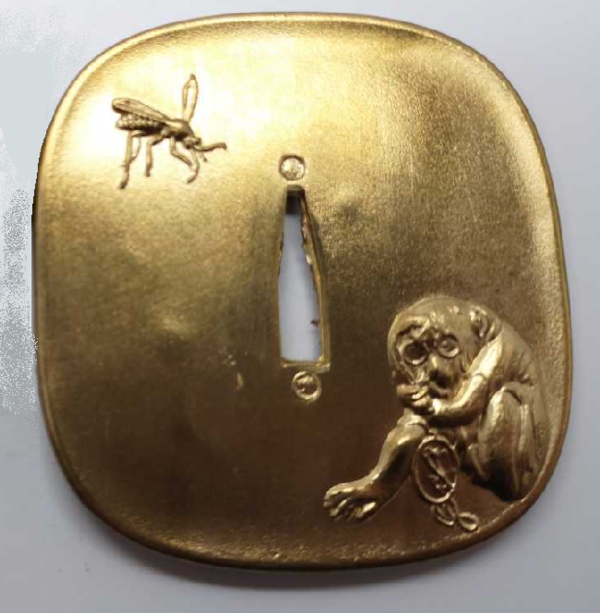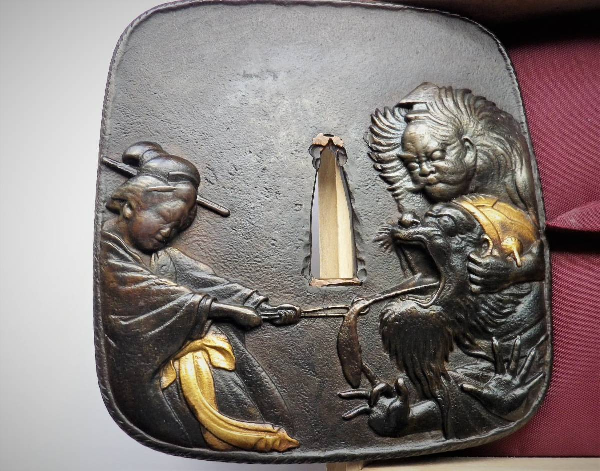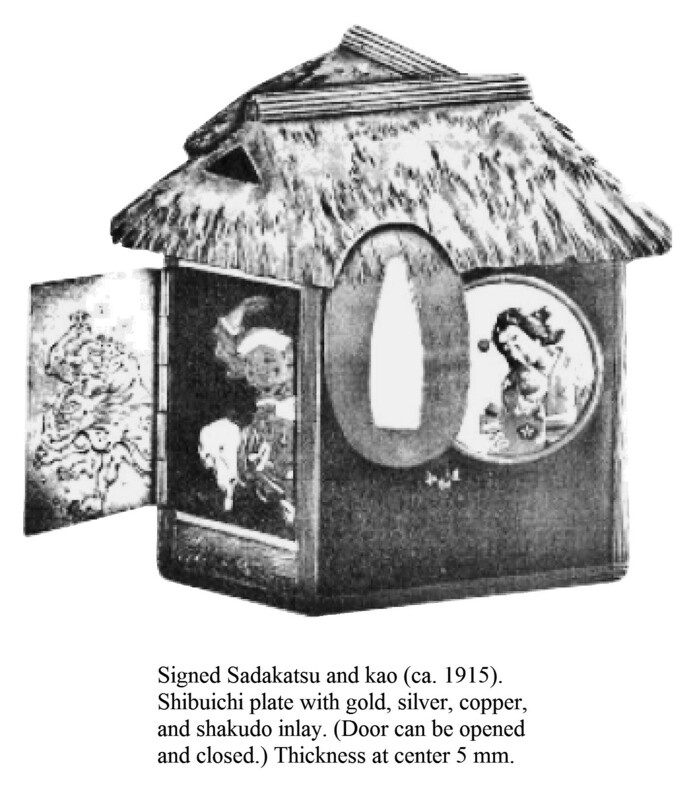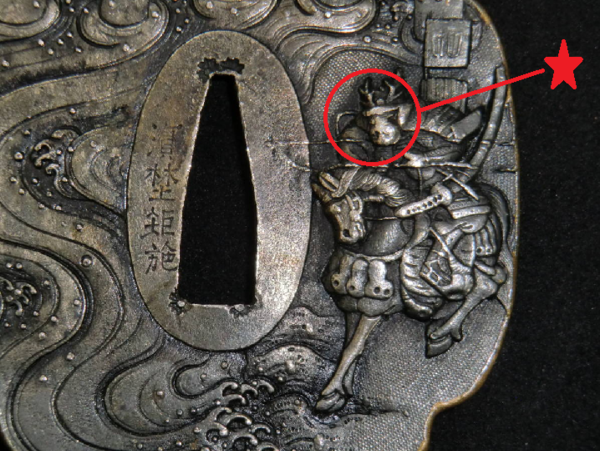-
Posts
3,694 -
Joined
-
Last visited
-
Days Won
100
Content Type
Profiles
Forums
Events
Store
Downloads
Gallery
Everything posted by Spartancrest
-
Barry you may be right - except no one seems to know what the view is - locally famous? 'Three Sisters' comes to mind, famous in NSW but not so much elsewhere. I am intrigued by my guard and others that I own, the sharp edges are not ideal for traditional Japanese clothing [ yes I know the tsuka was positioned out from the body but they must have caught on things occasionally ]
-
Jean All things are possible, if it did have a ring or even a fukurin there is no evidence left, the sides are all the same patina and no file marks or chisel cuts. It's size is not small really 87.4 mm x 64.3 mm and 4 mm thick. I was interested in what the jagged profile represents - the 'shoami' example does fit with a mountain theme rather than kiri-mon but why would it be symmetrical ? All the other examples apart from the first post are not symmetrical top to bottom.
-
Mauro - you may be right about the similarity, there is one just listed almost the same as the ones you posted. https://www.jauce.com/auction/r477171399 the side design is lower than the ones above so it is a step further to have them even lower still, like the original post. I notice the small kogai -hitsu-ana is like your first image. Evolution of a design.
-
This famous tsuba of a monkey and hovering wasp was recently featured in a NMB post, the guard is found in the Museum of Fine Arts Boston. There is a rather shoddy reproduction selling now https://www.jauce.com/auction/w460657968 it is pretty poor and I can't see it fooling many.
-
Yas - I feel so sorry for whoever 'won' that auction, all fakes [maybe the Mino real but very low quality?] 51,000 yen !!! This common reproduction is starting at a very high price as well. https://www.jauce.com/auction/s814150095 And check these three - https://www.jauce.com/auction/o461771927 https://www.jauce.com/auction/c894148996 https://www.jauce.com/auction/w436961534 what a huge price difference for mass produced reproductions.
-
I have had a strange shaped guard for some time, jagged top and bottom in a repeated pattern. I later noticed a guard from the Sir Arthur H Church collection that had the same pattern with a protective ring over the edges. Today yet another with the same features has appeared for auction. Three very different guards but the same silhouette 'mountains'? I checked the Church example and found it is the exact size match for my guard? Different styles using the same design book perhaps?
-
Hi Greg I have lately thought that "unique" is often optimistic. Of the more usual rain dragon type I have found at least 26 - examples and from correspondence with other members I have found numerous examples of their tsuba designs, duplicated. Utsushi seems to be the norm rather than the exception.
-
I wonder if anyone can help with the signature translation on this guard? I don't think it is ubu 生: It looks too thick and rounded - I don't have in hand yet, I bought it for its shape and design. 71 mm x 62 mm x 4 mm The design is one I have not seen before so if anyone has seen something similar I would appreciate the information. I have four examples of the more usual 'Rain Dragon' below. Thanks for any comments.
-
Sebastien isn't it a shame that the Dia has lost the fish head and some of the holly, otherwise they look in good condition.
-
Sebastien I have found a daisho set selling on Jauce with the same Sardine and Holly theme as yours. https://www.jauce.com/auction/j716876105 I hope the images are of some use.
-
For all those still interested in kutsuwa tsuba you may wish to see one going for auction https://www.jauce.com/auction/l663585368 The wisteria mitsu tomoe sukashi doesn't leave a lot of metal around the nakago-ana. The central area looks similar to a guard from the Ashmolean Museum. http://jameelcentre.ashmolean.org/object/EAX.10192
-
I am unsure if this PDF article has been posted before, it dates from 2012 Samurai-Evolution-of-Arms-Armors (2).pdf
-
- 1
-

-
Has anyone got any information on this totally impractical sword guard? Any ideas where the image can be found? Is it a novelty or was it meant to sell to tourists? Thanks in advance.
-

Interesting Pdf Articles And Links
Spartancrest replied to Brian's topic in General Nihonto Related Discussion
Thank you Brian for adding that and the "Etiquette of Seppuku" to the downloads, I must apologize for the image quality of the Metropolitan Museum auction, I have to lay the fault with Christies for the low resolution images. -
There is a similar themed tsuba in the Walters Art Museum. https://art.thewalters.org/detail/20774/tsuba-with-grapevine-and-squirrels/ There is also a Cloisonné piece in the Brooklyn Museum - unfortunately all their examples are in B&W The Ashmolean Museum also has several in the same theme of which these are two. http://jameelcentre.ashmolean.org/collection/7/10237/10374
-
NAILED IT !!! New class of tsuba - Ko Katchushi Kinky !!!
-
Barry, I have a strange way of looking at things [Asperger's], it could just as easily be a Japanese inflatable beach lounger with head rests - no not really.
-
-
Stephen - I did the complete illustrated edition of the Georg Oeder collection back in 2017 it has been on the book market since then, with 213 illustrated tsuba and a collection of 48 tsuba from the Baron of Biegeleben a minister of the Archduke Franz Ferdinand of Austria [whose assassination caused the outbreak of WWI] All translated from the original German into English. The link to the public domain photos has only 45 in total, but it is a good primer for the collection - all of which has 'gone missing' since the Russians took Berlin in 1945. This was the main reason I did the book, in hopes that someone might recognize any still existing pieces. https://www.amazon.com.au/Japanese-Decoration-ornament-collection-Dusseldorf/dp/1364114488 https://www.dymocks.com.au/book/Japanese-sword-guards-and-decoration-and-ornament-in-the-collection-of-georg-oeder-of-dusseldorf-1916-by-d-r-raisbeck-9781364114480 https://www.booktopia.com.au/Japanese-sword-guards-decoration-and-ornament-in-the-collection-of-georg-oeder-of-dusseldorf-1916-georg-oeder/book/9781389339271.html https://www.ebay.com/p/240673898 https://www.abebooks.com/9781389339271/Japanese-Sword-guards-Decoration-ornament-1389339270/plp
-
Richard - The way it works now is the Museum sells its excess to collectors [or investors] they grow old and die leaving their collections to the Museum who sell them on - ad nauseam. Hell why not lease the lot out! How much money for hanging "Self portrait with a Straw hat " by Vincent van Gogh, or 'Washington crossing the Delaware" on your wall for a week? Where does it ever end - - with an empty building that still needs to be maintained. Sorry but the almighty dollar should not dictate what is or is not worth preserving. The interest rate at the moment on that 3.3 Billion is 6.4 Million a year approx - that should employ a lot of people.
-
We do now! Great reference for design on Tosogu. Thanks for bring it to our attention.
-
For members information the Metropolitan Museum of Art receives an endowment of $3.3 Billion [ that's a B ] and has a number of billionaires on its board. So could anyone justify a sell-off of any of its collection, even if it was closed to visitors for a year due to covid?
-
I wish we had the same laws in this respect, as Japan does. There is a bad mistake with the listing of two lots on Christies Auction site - LOT 251 & LOT 252 - I wonder if it caused trouble at the actual auction? You will see there are only five tsuba pictured [three are duplicated in the lot photos] however eight tsuba are described - this has resulted in three tsuba being without images and if it had been me bidding, I would like to know what I am bidding on? Because of this error we have no record of the images for at least these three tsuba. I have heard that Christies have got this wrong before.
-
Yas - The Metropolitan Museum of Art already sold a large number of tsuba back in 2006. [Christies Auction of Japanese Art 28th March 2006 Sale 1638 ] I collected the images and information into book form so that they would not be entirely lost - My advice is don't donate to that Museum - they are only in it for the money and won't preserve your gifts. All these guards were gifted to the museum and are now in private hands around the world.
-
Hi Yas, another Hamano Noriyuki reproduction - "Silver" this time [Don't think so!] https://www.jauce.com/auction/c896249242 The face as usual is worn away, the inscription and other details are not too bad, the ura has casting faults in the seppa-dai. They must have made plenty of them that's for sure, they keep turning up. These are back again as well : https://www.jauce.com/auction/m480343769 , https://www.jauce.com/auction/h542120189

























